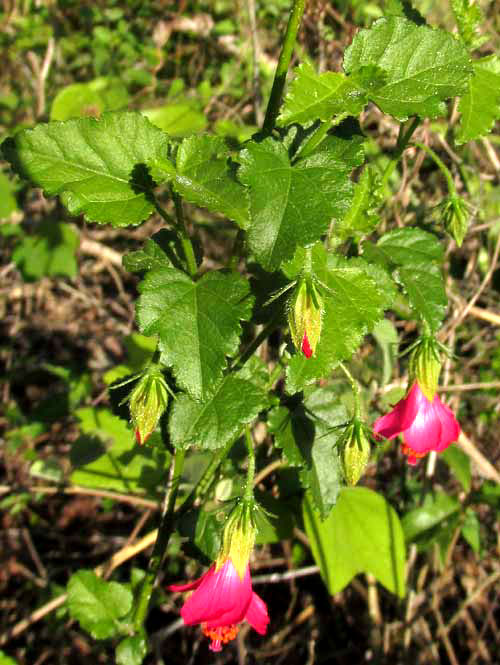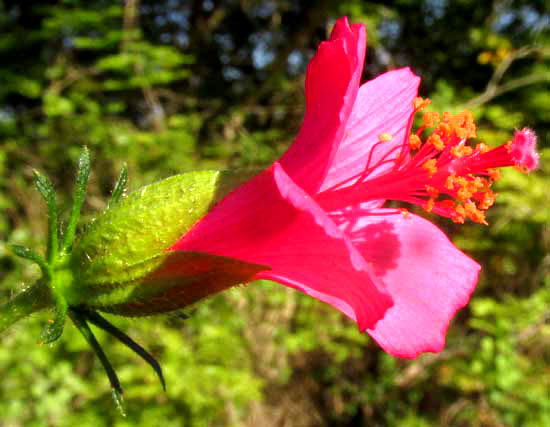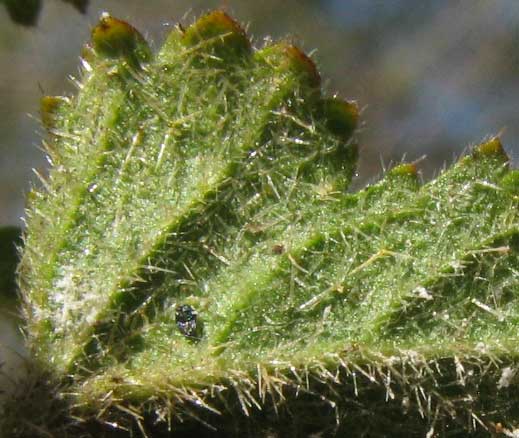Excerpts from Jim Conrad's
Naturalist Newsletter
from the May 24, 2018 Newsletter issued from Rancho Regenesis in the woods ±4kms west of Ek Balam Ruins; elevation ~40m (~130 ft), N~20.876°, W~88.170°; central Yucatán, MÉXICO
FAIRY HIBISCUS FLOWERING
In very thin, dry soil atop a dislodged limestone boulder along the road to Temozón, a bright splash of rose-red color caught my eye. Below, you can see what it was:

With such flowers and leaves it could hardly be anything other than a member of the big Hibiscus Family. Up close, a beautiful blossom confirms this with its numerous stamens' slender filaments joined at their bases to form a cylinder -- the "staminal column" -- surrounding the long style, as shown below:

The flower's single pistil with its stigma-tipped style branches spreading away from one another above the cluster of yellow-orange anthers, its five-toothed calyx, and the collar of several bracts below the calyx, all point to the genus Hibiscus.
Though many Hibiscus species are favorite ornamentals, and this one would be an attraction in any garden, in our area it's considered a weed. It's HIBISCUS POEPPIGII, in English sometimes known as the Poeppig's Rosemallow or Fairy Hibiscus. It's native from southern Florida through Mexico into Guatemala, as well as Cuba and Jamaica. Here it flowers and fruits more or less throughout the year, whenever there's enough rain. With enough water it can reach seven feet tall (2m) but ours was only about one foot tall.
from the February 6, 2011 Newsletter issued from Hacienda Chichen Resort beside Chichén Itzá Ruins, central Yucatán, MÉXICO
FAIRY HIBISCUS FRUITING

Also in an abandoned lot in Pisté stood a head-tall plant with bright red flowers 1-1/3 inch long (3.5cm) shown above.
With stamens arising from a cylinder surrounding the five-branched style like that, you probably recognize the plant as a member of the Hibiscus Family. In fact it's a member of the genus Hibiscus itself, HIBISCUS POEPPIGII, sometimes called Fairy Hibiscus, Poeppig's Rosemallow and other names. The species is limited to Mexico, Guatemala, The Antilles, and southern Florida. In Florida it's listed as endangered.
In the picture, the fuzzy items below the flowers are seeds affixed with long hairs, the hairs surely aiding in dissemination by wind. Seeing such seeds you can easily imagine how the cotton plant evolved its fiber-embedded seeds, and cotton also is a member of the Hibiscus Family. If you look closely you can also make out the Hibiscus's open capsule which, before it opened to release seeds, was shaped somewhat like a cotton plant's boll.
A field mark distinguishing this from other hibiscus species is that many of its vegetative parts are thickly invested with sharp, branched hairs -- "stellate" hairs -- as shown below:
